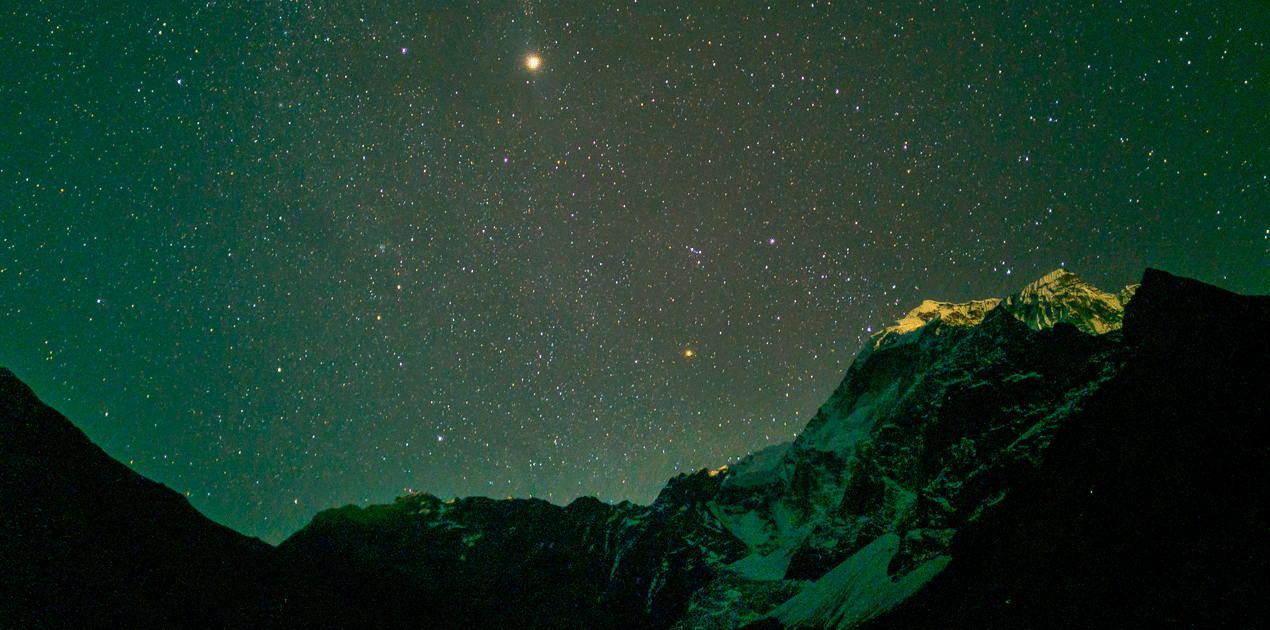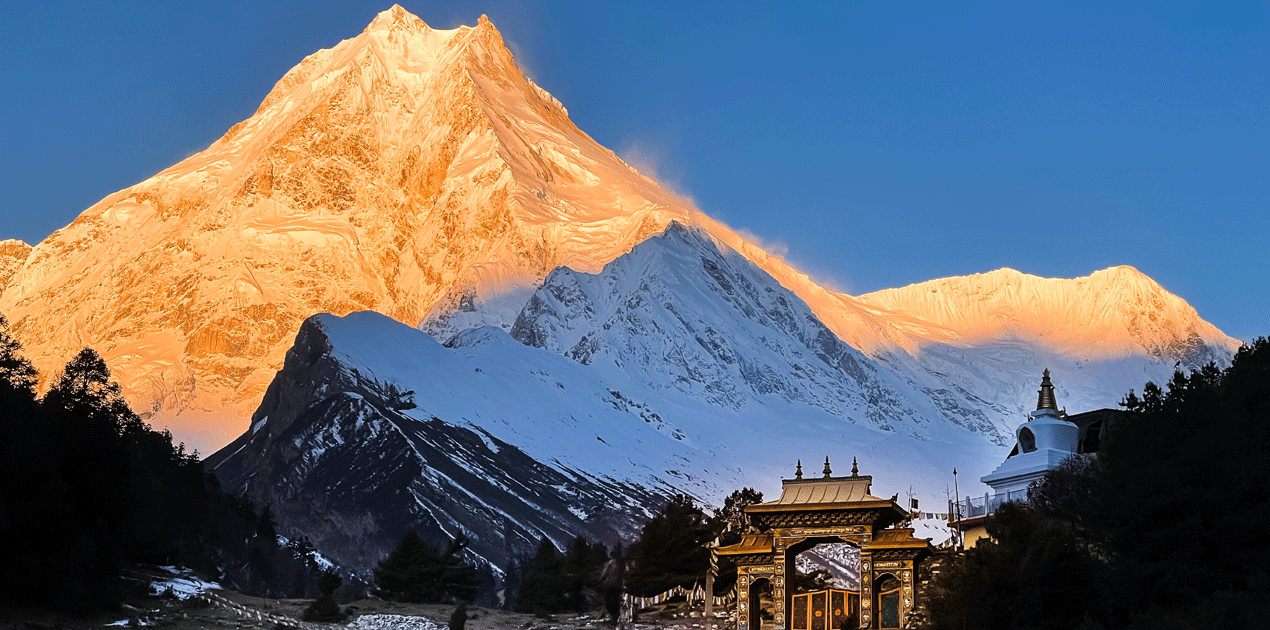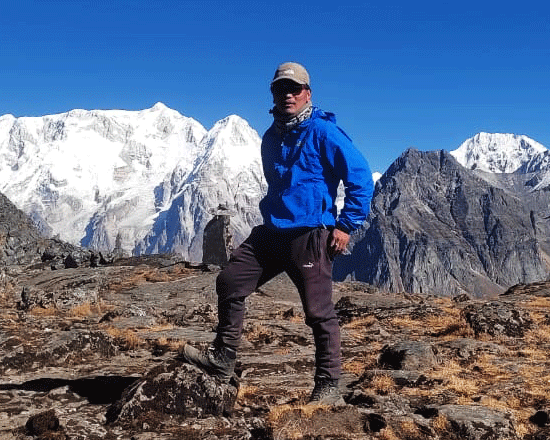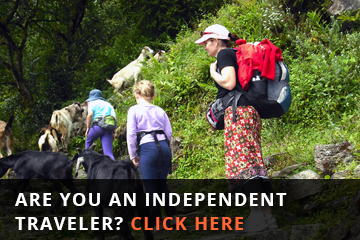Manaslu Annapurna Circuit Trek
Manaslu Annapurna Circuit Trek
Wilderness TrekkingTrip Facts
Since the terrain can be hard and the days long, hikers on these treks should be in good physical condition and have some previous mountain walking experience. Steep climbing may be involved, although it is never necessary to use ropes. Treks at this level can he arranged for periods of 16 to 21 days. Typically, a gradual ascent through a green river valley will lead you up to a number of high passes, where you will reach the altitude of 5416m. Often times, you will get a close insight into the Tibetan culture. Participants should expect to trek above 5416m/17872ft.
100%
Overview
Manaslu Annapurna Circuit Trek Where Two Legendary Treks Converge
Imagine a trekking experience that weaves together the raw, untouched wilderness of the Manaslu region with the iconic Annapurna Circuit, creating an unparalleled Himalayan adventure that challenges your limits and rewards you with breathtaking landscapes, rich cultural encounters, and an intimate connection with Nepal’s mountain heritage. The Manaslu Annapurna Circuit Trek is not just a journey but a transformative expedition combining two of Nepal’s most stunning trekking routes into one extraordinary odyssey.
The Unique Landscape of Manaslu Annapurna Circuit Trek: A Tapestry of Natural Wonders
The Manaslu Annapurna circuit trek begins in the less-traveled Manaslu region, a pristine wilderness that offers a more raw and authentic trekking experience. Mount Manaslu, the eighth-highest peak in the world, stands as a sentinel watching over the landscape, its 8,163-meter height dominating the horizon. The Manaslu expedition begins from the Samagaun valley. The expeditions are held in both seasons. Unlike the more popular trekking routes, the Manaslu region remains relatively untouched, providing trekkers with a sense of true wilderness and isolation.
As you navigate this remarkable terrain, you’ll traverse diverse ecological zones. The journey starts from the lower Manaslu valley untouched by lush subtropical forests, gradually ascending through the temperate forests of rhododendrons and pine, before emerging into the stark, breathtaking alpine landscapes. The region is home to an incredible variety of wildlife, including the elusive snow leopard, Himalayan tahr, and numerous bird species that call these mountains home.
Annapurna Circuit Trek: A Classic Himalayan Route
The trek seamlessly transitions into the legendary Annapurna Circuit, a route that has captured the imagination of trekkers worldwide. Here, you’ll encounter a dramatic landscape of some of the world’s deepest gorges, towering peaks, and the challenging Thorong La Pass at 5,416 meters. The Annapurna circuit treks natural beauty and cultural richness, with panoramic views of mountains like Annapurna II, III, IV, Gangapurna, and Dhaulagiri. Moreover, the trek can also be concluded by adding the Annapurna base camp trek. The trek is one of the popular destinations chosen by many trekkers wishing to capture the thrilling mountains on their lap.
Cultural Immersion: Beyond the Mountains
The Manaslu circuit trek serves more as a cultural journey as the people from the region are more deeply rooted in their lifestyle, culture, and religion. You’ll pass through communities of diverse ethnic groups, each with unique traditions, languages, and ways of life. In the Manaslu circuit trek, you’ll encounter Tibetan-influenced communities like the Nubri and Tsum, known for their distinctive Buddhist practices and traditional lifestyle. The Annapurna region introduces you to Gurung, Thakali, and Magar communities, each offering warm hospitality and insights into their rich cultural heritage.
Traditional Mountain Villages of Manaslu Annapurna Circuit Trek
Trekking through villages like Samagaon, Samdo, and Dharapani,Chame, and Manang you’ll witness a way of life that has remained largely unchanged for centuries. Stone houses, Buddhist monasteries, prayer wheels, and terraced fields create a picturesque landscape that tells the story of mountain survival and spiritual connection.
Physical Challenge and Preparation
The Manaslu Annapurna Circuit Trek is not for the faint-hearted. It presents significant physical challenges, with daily hiking distances ranging from 6 to 8 hours and altitudes reaching over 5,400 meters. Trekkers must be in excellent physical condition and preferably have previous high-altitude trekking experience.
Essential Tips for Manaslu Annapurna Circuit Trek
– Physical Training: Begin a comprehensive fitness regime 3-6 months before the trek.
– Altitude Acclimatization: Include rest days and gradual ascent to prevent altitude sickness.
– Technical Gear: High-quality trekking boots, layered clothing, and proper cold-weather equipment are crucial.
– Medical Preparation: Comprehensive health check-up and necessary vaccinations.
– Mental Preparation: Develop mental resilience and a positive attitude.
Seasons Overview
Nepal experiences four primary seasons:
- Spring (March-May): Pre-monsoon season.
- Summer/Monsoon (June–August): Wet season.
- Autumn (September–November): Post-monsoon season.
- Winter (December–February): Cold season.
Best Season for Manaslu Annapurna Circuit Trek
The spring and autumn seasons are widely regarded as the best time to trek to the Manaslu Annapurna circuit trek.
1. Spring (March to May)
- Spring is one of the most popular times for trekking in Nepal.
- The weather is mild, and the skies are generally clear in the mornings.
Pros
- Flora and Fauna: The trails cover blooming rhododendrons, magnolias, and orchids. The Manaslu Annapurna circuit trek is an excellent time for nature lovers during this month.
- Stable Weather: Daytime temperatures are comfortable, ranging from 10°C to 20°C at lower altitudes and 0°C to -10°C at higher elevations.
- Views: Stunning visibility of mountains like Annapurna II, III, IV, Gangapurna, Dhaulagiri, and Manaslu.
Challenges:
- Higher foot traffic and Occasional pre-monsoon haze in the lower valley.
2. Autumn (September to November)
- Considered the best time for trekking in Nepal due to ideal weather conditions and crystal-clear skies.
Pros:
- Clear Skies: The monsoon rains clear away dust and pollution, offering exceptional visibility of the mountains and landscapes.
- Stable Weather: Warm days and cool nights, with daytime temperatures ranging from 10°C to 18°C in lower areas and -5°C to -15°C at higher altitudes. Season of the Hindu festival( Dashain and Tihar).
Challenges:
- Moderate crowd levels, though still quieter compared to other treks.
3. Winter (December to February)
- Winter is off-season for trekking to Manaslu Annapurna circuit trek due to cold temperatures and heavy snowfall at higher altitudes.
Pros:
- Solitude: Fewer trekkers on the trail, providing a more peaceful experience.
- Crisp Views: Cold weather ensures incredibly sharp visibility on clear days.
Challenges:
- Cold Temperatures: Can drop below -20°C at higher elevations.
- Snowfall: Heavy snow may block trails and passes, especially near Thorong Pass, Larke La Pass, and the base camp. Limited tea houses on the way.
Permits and Logistics
– Manaslu Conservation Area Permit.
– Annapurna Conservation Area Permit.
– Special Restricted Area Permit for Manaslu.
– TIMS (Trekkers’ Information Management Systems) Card.
Recommended Support
While experienced trekkers might consider an independent trek, we strongly recommend:
– Experienced local guide
– Porter support
– Organized trekking package for safety and logistical ease
Environmental Consciousness
– Follow “Leave No Trace” principles.
– Minimize plastic waste.
– Respect local cultural and environmental sensitivities.
– Support local economies through responsible tourism.
Unique Highlights of the Trek
- Crossing Thorong La Pass: A challenging yet rewarding high-altitude mountain pass.
- Diverse Ecosystems: From subtropical forests to alpine deserts.
- Cultural Encounters: Immersion in Tibetan Buddhist and traditional mountain cultures.
- Stunning Mountain Panoramas: Uninterrupted views of some of the world’s highest peaks.
Conclusion: More Than Just a Trek
The Manaslu Annapurna Circuit Trek is a life-changing journey that goes far beyond a simple walking expedition. It’s an opportunity to challenge your physical limits, connect with ancient cultures, and witness some of the most spectacular landscapes on our planet. Every step is a story, every view a masterpiece, and every moment an opportunity for personal transformation.
Are you ready to embark on the ultimate Himalayan adventure?
Note: Always trek with a certified guide, respect local cultures, and prioritize your safety and the preservation of these magnificent mountain environments.
Detail Itinerary
- Day 01: Drive from Machha Khola to Jagat
The adventure begins with a scenic drive from Machha Khola to Jagat, covering approximately 22 kilometers in 7 to 8 hours. This journey passes through lush green landscapes, terraced fields, and the roaring Budhi Gandaki River. Jagat, a quaint village at 1,340 meters, marks the gateway to the Manaslu Conservation Area. - Day 02: Trek from Jagat to Deng
This day involves a 20-kilometer trek, taking 6 to 7 hours. The trail meanders through dense forests and traditional villages, crossing suspension bridges over the Budhi Gandaki River. Pass through Philim, known for its terraced fields and cultural significance, before arriving at Deng (1,860 meters), a peaceful village surrounded by breathtaking views. - Day 03: Trek from Deng to Namrung
The trek from Deng to Namrung covers 19 kilometers and takes about 6 to 7 hours. Ascend through rhododendron forests, cross rivers on wooden bridges, and pass through the culturally rich village of Ghap. Namrung, at 2,630 meters, offers incredible mountain views and a glimpse into Tibetan-influenced lifestyles. - Day 04: Trek from Namrung to Lho
The trail from Namrung to Lho is relatively short at 11 kilometers, taking 4 to 5 hours. Along the way, enjoy panoramic views of snow-capped peaks, charming mani walls, and ancient prayer wheels. Lho, situated at 3,180 meters, is famous for its monastery and stunning views of Mt. Manaslu. - Day 05: Trek from Lho to Samagaon
A leisurely 7-kilometer trek, taking 3 to 4 hours, leads to Samagaon, located at 3,520 meters. The trail offers mesmerizing views of glaciers and peaks. Upon reaching Samagaon, explore the village and acclimatize while enjoying the rich Tibetan culture. - Day 06: Trek from Samagaon to Samdo
The 9-kilometer journey to Samdo, taking 3 to 4 hours, gradually ascends to an altitude of 3,860 meters. This serene trail provides expansive views of the surrounding mountains and valleys. Samdo, a small village near the Tibetan border, offers a tranquil setting to explore the local culture. - Day 07: Trek from Samdo to Dharamsala
The trail to Dharamsala (Larkya Phedi) spans 12 kilometers, requiring 4 to 5 hours of trekking. Ascend through rugged terrain with increasing altitude, reaching 4,460 meters. Dharamsala is the base camp for the Larkya La Pass, surrounded by dramatic mountain vistas. - Day 08: Trek from Dharamsala to Bhimthang via Larkya La Pass
This challenging day involves crossing the 5,106-meter-high Larkya La Pass, trekking 25 kilometers in 8 to 9 hours. Start early to witness spectacular sunrise views over peaks like Himlung Himal and Cheo Himal. Descend to Bhimthang, an alpine meadow with breathtaking landscapes. - Day 09: Trek from Bhimthang to Dharapani
Descend 22 kilometers in 7 to 8 hours through lush rhododendron and pine forests, passing waterfalls and streams. The trail gradually transitions into cultivated fields as you approach Dharapani, located at 1,963 meters. - Day 10: Trek from Dharapani to Chame
Covering 15.5 kilometers in 5 to 6 hours, this leg of the trek ascends along the Marshyangdi River. Pass through forests and small settlements, enjoying views of Annapurna II and Lamjung Himal. Chame, at 2,610 meters, serves as a key stop on the Annapurna Circuit. - Day 11: Trek from Chame to Upper Pisang
The trek from Chame to Upper Pisang spans 13.5 kilometers and takes 5 to 6 hours. The trail offers stunning views of the Marshyangdi Valley and towering peaks. Upper Pisang, at 3,300 meters, is a traditional village with a prominent monastery and panoramic mountain views. - Day 12: Trek from Upper Pisang to Manang
This 17.2-kilometer trek takes 7 to 8 hours, winding through forests and alpine meadows. The trail offers changing landscapes as you ascend toward Manang (3,540 meters), a hub for acclimatization with attractions like Gangapurna Lake and local cultural sites. - Day 13: Trek from Manang to Ledar
A shorter trekking day of 9.1 kilometers, taking 3 to 4 hours involves a gradual ascent to Ledar (4,200 meters). The route offers stunning views of Annapurna and glimpses of Himalayan wildlife, including blue sheep. - Day 14: Trek from Ledar to Thorung Phedi
The 7.3-kilometer trek to Thorung Phedi takes 4 to 5 hours. Ascend through rugged landscapes and rocky paths, reaching an altitude of 4,525 meters. Thorung Phedi serves as the base for the Thorong La Pass crossing. - Day 15: Trek from Thorung Phedi to Muktinath via Thorong La Pass
This iconic day covers 15.6 kilometers in 8 to 9 hours, crossing the 5,416-meter-high Thorong La Pass. Start early to enjoy panoramic views of the Annapurna and Dhaulagiri ranges. Descend to Muktinath (3,800 meters), a revered pilgrimage site for Hindus and Buddhists. - Day 16: Trek from Muktinath to Jomsom
Descend 16.4 kilometers in 8 to 9 hours through the Kali Gandaki Valley. Pass through Kagbeni, a picturesque village, before arriving at Jomsom (2,720 meters), known for its windy terrain and apple orchards. - Day 17: Fly back to Pokhara
Take a short yet scenic flight from Jomsom to Pokhara, enjoying aerial views of the Annapurna and Dhaulagiri ranges. Spend the rest of the day exploring Pokhara’s tranquil lakeside attractions.
Cost Included
- Kathmandu to Machhakhola bus
- Jomsom to Pokhara flight
- Italian, Chinese, Nepali, Indian, and many other European delicious Meals three times a day (Breakfast, lunch, and dinner chosen by Menu)
- Clean accommodation on the Lodge during the trekking.
- One experienced, educated, well-trained, fluent English speaking, friendly, and familiar guide, from the same area and specialized in Manaslu trekking region and government-authorized trekking guide.
- One porter for every two to three participants. (Note: An additional cost applies for solo clients requiring a porter.)
- Guide and Porter accommodation, salary, insurance, transportation, and types of equipment.
- Manaslu area special permit
- ACAP (Annapurna Conservation Area Project) and MCAP( Manaslu Conservation Area Project) permits
- First aid medical box.
- Trekking equipment as a sleeping bag and down jacket etc. if you don't have your own
- Complementary Trekking Certificate of Completion.
Cost Excluded
- Kathmandu and Pokhara hotels
- all beverages, Soft and hard table drinks such as coke, beer, Fanta, mineral water, hot shower, dessert, etc.
- Personal insurance.
- Rescue operation charge.
- Tips for Guide and Porter.
- Excluded are all costs and expenses not listed under "cost includes"
- Inclusion of costs or delays beyond the control of the management, such as landslides, weather conditions, itinerary modifications due to safety concerns, illness, changes in government policies, strikes, etc.












